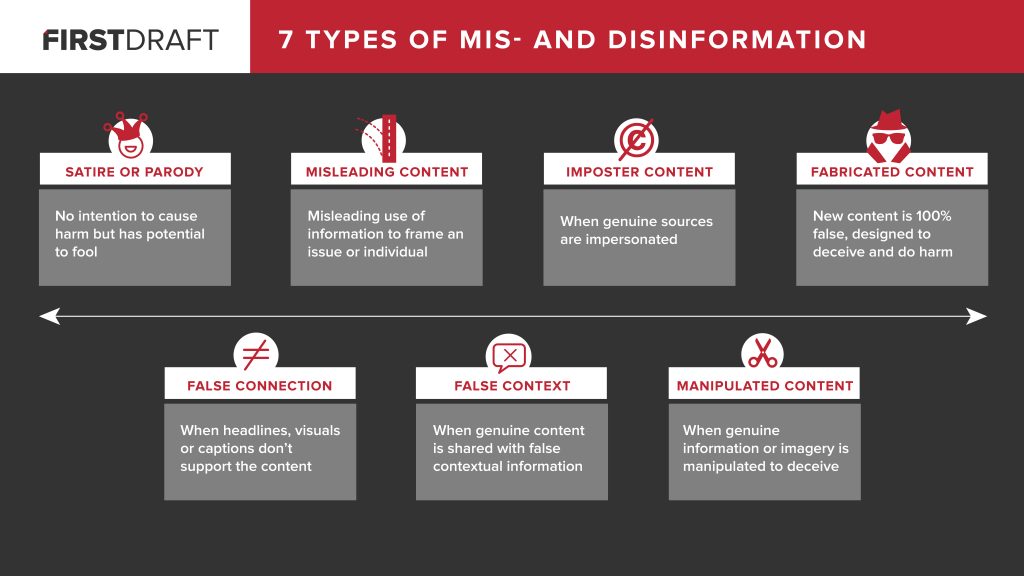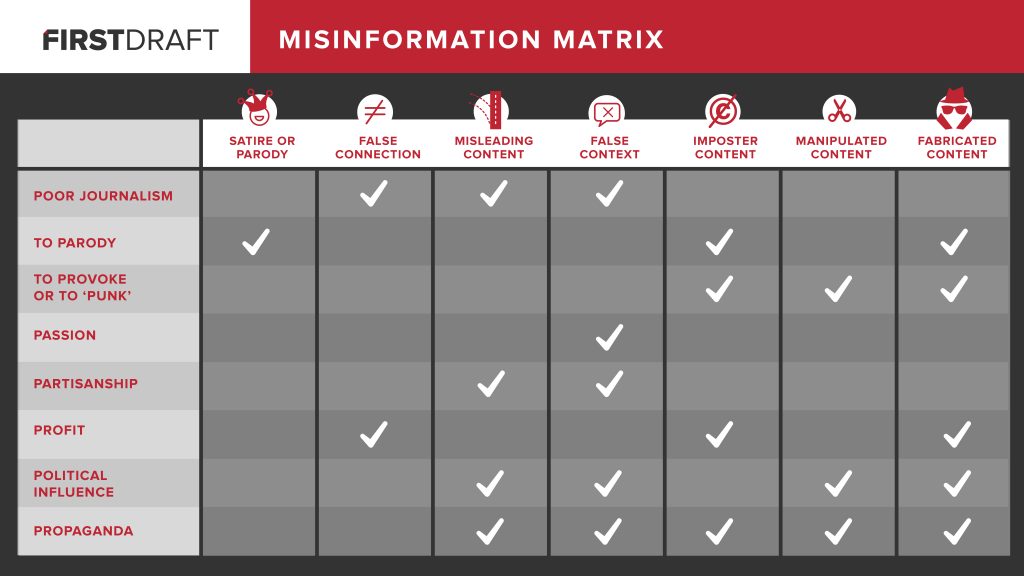
Spotting fake news in your feed has always been tough. Now it just got tougher, thanks to AI.
Fake news crops up in plenty of places on social media. And it has for some time now. In years past, it took the form of misleading posts, image captions, quotes, and the sharing of outright false information in graphs and charts. Now with the advent of AI, we see fake news taken to new levels of deception:
- Deepfake videos that mimic the looks and parrot the words of well-known public figures.
- AI-generated voice clones that sound spooky close to the voices they mimic.
- Also, entire news websites generated by AI, rife with bogus stories and imagery.
All of it’s out there. And knowing how to separate truth from fact has never been of more importance, particularly as more and more people get their news via social media.
Pew Research found that about a third of Americans say they regularly get their news from Facebook and nearly 1 in 4 say they regularly get it from YouTube. Moreover, global research from Reuters uncovered that more people primarily get their news from social media (30%) rather than from an established news site or app (22%). This marks the first time that social media has toppled direct access to news.
Yet, you can spot fake news. Plenty of it.
The process starts with a crisp definition of what fake news is, followed by the forms it takes, and then a sense of what the goals behind it are. With that, you can apply a critical eye and pick out the telltale signs.
We’ll cover it all here.
What is fake news?
A textbook definition of fake news goes something like this:
A false news story, fabricated with no verifiable facts, and presented in a way to appear as legitimate news.
As for its intent, fake news often seeks to damage the reputation of an individual, institution, or organization. It might also spout propaganda or attempt to undermine established facts.
That provides a broad definition. Yet, like much fake news itself, the full definition is much more nuanced. Within fake news, you’ll find two categories: disinformation and misinformation:
- Disinformation: This is intentionally misleading information that’s been manipulated to create a flat-out lie—typically with an ulterior motive in mind. Here, the creator knows that the information is false.
- Example: As a bad joke, a person concocts a phony news story that a much-anticipated video game release just got canceled. However, the game will certainly see its release. In the meantime, word spreads and online fans whip up into a frenzy.
- Misinformation: This simply involves getting the facts wrong. Unknowingly so, which separates itself from disinformation. We’re only human, and sometimes that means we forget details or recall things incorrectly. Likewise, when a person shares disinformation, that’s a form of misinformation as well, if the person shares it without fact-checking.
- Example: A person sees a post that a celebrity has died and shares that post with their friends and followers—when in fact, that celebrity is still very much alive.
From there, fake news gets more nuanced still. Misinformation and disinformation fall within a range. Some of it might appear comical, while other types might have the potential to do actual harm.
Dr. Claire Wardle, the co-director of the Information Futures Lab at Brown University, cites seven types of misinformation and disinformation on a scale as visualized below:

Source – FirstDraftNews.org and Brown University
Put in a real-life context, you can probably conjure up plenty of examples where you’ve seen. Like clickbait-y headlines that link to letdown articles with little substance. Maybe you’ve seen a quote pasted on the image of a public figure, a quote that person never made. Perhaps an infographic, loaded with bogus statistics and attributed to an organization that doesn’t even exist. It can take all forms.
Who’s behind fake news? And why?
The answers here vary as well. Greatly so. Fake news can begin with a single individual, groups of like-minded individuals with an agenda, and it can even come from operatives for various nation-states. As for why, they might want to poke fun at someone, drive ad revenue through clickbait articles, or spout propaganda.
Once more, a visualization provides clarity in this sometimes-murky mix of fake news:

Source – FirstDraftNews.org and Brown University
In the wild, some examples of fake news and the reasons behind it might look like this:
- Imposter sites that pose as legitimate news outlets yet post entirely unfounded pieces of propaganda.
- Parody sites that can look legitimate, so much so that people might mistake their content for actual news.
- AI deepfakes, images, recordings, and videos of public figures in embarrassing situations, yet that get presented as “real news” to damage their reputation.
Perhaps a few of these examples ring a bell. You might have come across some where you weren’t exactly sure if it was fake news or not.
The following tools can help you know for sure.
Spotting what’s real and fake in your social media feed.
Consider the source
Some of the oldest advice is the best advice, and that holds true here: consider the source. Take time to examine the information you come across. Look at its source. Does that source have a track record of honesty and dealing plainly with the facts?
- For an infographic, you can search for the name of its author or the institution that’s attributed to it. Are they even real in the first place?
- For news websites, check out their “About Us” pages. Many bogus sites skimp on information here, whereas legitimate sites will go to lengths about their editorial history and staff.
- For any content that has any citation listed to legitimize it as fact, search on it. Plenty of fake news uses sources and citations that are just as fake too.
Check the date
This falls under a similar category as “consider the source.” Plenty of fake news will take an old story and repost it or alter it in some way to make it appear relevant to current events. In recent years, we’ve seen fake news creators slap a new headline on a new photo, all to make it seem like it’s something current. Once again, a quick search can help you tell if it’s fake or not. Try a reverse image search and see what comes up. Is the photo indeed current? Who took it? When? Where?
Check your emotions too
Has a news story you’ve read or watched ever made you shake your fist at the screen or want to clap and cheer? How about something that made you fearful or simply laugh? Bits of content that evoke strong emotional responses tend to spread quickly, whether they’re articles, a post, or even a tweet. That’s a ready sign that a quick fact check might be in order. The content is clearly playing to your biases.
There’s a good reason for that. Bad actors who wish to foment unrest, unease, or spread disinformation use emotionally driven content to plant a seed. Whether or not their original story gets picked up and viewed firsthand doesn’t matter to these bad actors. Their aim is to get some manner of disinformation out into the ecosystem. They rely on others who will re-post, re-tweet, or otherwise pass it along on their behalf—to the point where the original source of the information gets completely lost. This is one instance where people readily begin to accept certain information as fact, even if it’s not factual at all.
Certainly, some legitimate articles will generate a response as well, yet it’s a good habit to do a quick fact check and confirm what you’ve read.
Expand your media diet
A single information source or story won’t provide a complete picture. It might only cover a topic from a certain angle or narrow focus. Likewise, information sources are helmed by editors and stories are written by people—all of whom have their biases, whether overt or subtle. It’s for this reason that expanding your media diet to include a broad range of information sources is so important.
So, see what other information sources have to say on the same topic. Consuming news across a spectrum will expose you to thoughts and coverage you might not otherwise get if you keep your consumption to a handful of sources. The result is that you’re more broadly informed and can compare different sources and points of view. Using the tips above, you can find other reputable sources to round out your media diet.
Additionally, for a list of reputable information sources, along with the reasons they’re reputable, check out “10 Journalism Brands Where You Find Real Facts Rather Than Alternative Facts” published by Forbes and authored by an associate professor at The King’s College in New York City. It certainly isn’t the end all, be all of lists, yet it should provide you with a good starting point.
Let an expert do the fact-checking for you
De-bunking fake news takes time and effort. Often a bit of digging and research too. Professional fact-checkers at news and media organizations do this work daily. Posted for all to see, they provide a quick way to get your answers. Some fact-checking groups include:
Three ways to spot AI-generated fakes
As AI continues its evolution, it gets trickier and trickier to spot it in images, video, and audio. Advances in AI give images a clarity and crispness that they didn’t have before, deepfake videos play more smoothly, and voice cloning gets uncannily accurate.
Yet even with the best AI, scammers often leave their fingerprints all over the fake news content they create. Look for the following:
1) Consider the context
AI fakes usually don’t appear by themselves. There’s often text or a larger article around them. Inspect the text for typos, poor grammar, and overall poor composition. Look to see if the text even makes sense. And like legitimate news articles, does it include identifying information—like date, time, and place of publication, along with the author’s name.
2) Evaluate the claim
Does the image seem too bizarre to be real? Too good to be true? Today, “Don’t believe everything you read on the internet,” now includes “Don’t believe everything you see on the internet.” If a fake news story is claiming to be real, search for the headline elsewhere. If it’s truly noteworthy, other known and reputable sites will report on the event—and have done their own fact-checking.
3) Check for distortions
The bulk of AI technology still renders fingers and hands poorly. It often creates eyes that might have a soulless or dead look to them—or that show irregularities between them. Also, shadows might appear in places where they look unnatural. Further, the skin tone might look uneven. In deepfaked videos, the voice and facial expressions might not exactly line up, making the subject look robotic and stiff.
Be safe out there
The fact is that fake news isn’t going anywhere. It’s a reality of going online. And AI makes it tougher to spot.
At least at first glance. The best tool for spotting fake news is a fact-check. You can do the work yourself, or you can rely on trusted resources that have already done the work.
This takes time, which people don’t always spend because social platforms make it so quick and easy to share. If we can point to one reason fake news spreads so quickly, that’s it. In fact, social media platforms reward such behavior.
With that, keep an eye on your own habits. We forward news in our social media feeds too—so make sure that what you share is truthful too.
Be safe out there
Plenty of fake news can lure you into sketchy corners of the internet. Places where malware and phishing sites take root. Consider using comprehensive online protection software to keep safe. In addition to several features that protect your devices, privacy, and identity, they can warn you of unsafe sites too. While it might not sniff out AI content (yet), it offers strong protection against bad actors who might use fake news to steal your information or harm your data and devices.





